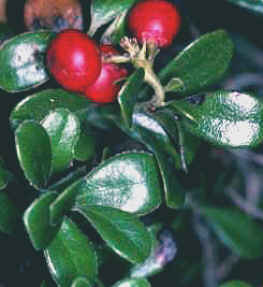
Plant Description
Caution & Interaction

Latin (botanical) name:
Arctostaphylos uva ursi
Common names: Arberry, Bearberry, Bear's Grape, Kinnikinnick, Mealberry, Mountain Box, Mountain Cranberry, Red Bearberry, Sagackhomi, Sandberry, Arberry, Hogberry
Plant Description: The Bearberry, or Uva Ursi, is a small shrub with a single long, fibrous main root that sends out many short, woody, trailing stems. They are covered in brown or reddish bark and form thick masses. Long shoots covered with soft hairs rise upward from the stems. The leaves of Uva Ursi are evergreen and leathery, about an inch long. The upper surface is glossy, dark green with deep veins, and a lighter green underneath. They are rounded at the apex and taper gradually toward the base to a short stalk. All the young leaves are also covered with tiny hairs. Uva Ursi's fruit is a smooth berry about the size of a currant. These berries are bright red, smooth and glossy, with a tough skin encasing mealy pulp and several 1-seeded stones. In May and June, the Bearberry blooms with waxy-looking flowers in drooping racemes, in groups of from 3 to 6. The flowers are bell-shaped and reddish-white, pink, or white with a red lip. Uva Ursi is found all over the northern hemisphere, in the high mountains of Europe, America, and Asia. In North America, it can be found throughout Canada and as far south as Wisconsin and New Jersey.
Medicinal Properties &Uses: The main constituent of Bearberry leaves is a crystallizable glucoside called Arbutin. Some other constituents include methyl-arbutin, gallic acid, ellagic acid, volatile oil, and about 6% tannin. Uva Ursi has a diuretic and astringent effect on urinary system membranes due to the glucoside Arbutin which is absorbed unchanged and excreted by the kidneys. During excretion, Arbutin shows an antiseptic effect on the urinary mucous membranes, which makes it effective in treatment of pyelitis, urethritis, and cystitis. It is specifically indicated in acute catarrhal cystitis where it helps to reduce accumulations of uric acid. Because of its high astringency, Uva Ursi is often used to treat diarrhea and reduce intestinal irritation. As a douche, it is a valuable treatment in vaginal ulceration and infection.
Dosage: 20-40 drops in water or juice, 2-3 times daily or as needed. Shake well before using.
Cautions & Interactions: Do not use during pregnancy. Keep out of reach of children.
Efficacy Studies & Other Clinical Data: Helpful Links:
Disclaimer (U.S. Only): These statements have not been evaluated by the FDA. These products are not intended to diagnose, cure, treat, or prevent any disease.
Common names: Arberry, Bearberry, Bear's Grape, Kinnikinnick, Mealberry, Mountain Box, Mountain Cranberry, Red Bearberry, Sagackhomi, Sandberry, Arberry, Hogberry
Plant Description: The Bearberry, or Uva Ursi, is a small shrub with a single long, fibrous main root that sends out many short, woody, trailing stems. They are covered in brown or reddish bark and form thick masses. Long shoots covered with soft hairs rise upward from the stems. The leaves of Uva Ursi are evergreen and leathery, about an inch long. The upper surface is glossy, dark green with deep veins, and a lighter green underneath. They are rounded at the apex and taper gradually toward the base to a short stalk. All the young leaves are also covered with tiny hairs. Uva Ursi's fruit is a smooth berry about the size of a currant. These berries are bright red, smooth and glossy, with a tough skin encasing mealy pulp and several 1-seeded stones. In May and June, the Bearberry blooms with waxy-looking flowers in drooping racemes, in groups of from 3 to 6. The flowers are bell-shaped and reddish-white, pink, or white with a red lip. Uva Ursi is found all over the northern hemisphere, in the high mountains of Europe, America, and Asia. In North America, it can be found throughout Canada and as far south as Wisconsin and New Jersey.
Medicinal Properties &Uses: The main constituent of Bearberry leaves is a crystallizable glucoside called Arbutin. Some other constituents include methyl-arbutin, gallic acid, ellagic acid, volatile oil, and about 6% tannin. Uva Ursi has a diuretic and astringent effect on urinary system membranes due to the glucoside Arbutin which is absorbed unchanged and excreted by the kidneys. During excretion, Arbutin shows an antiseptic effect on the urinary mucous membranes, which makes it effective in treatment of pyelitis, urethritis, and cystitis. It is specifically indicated in acute catarrhal cystitis where it helps to reduce accumulations of uric acid. Because of its high astringency, Uva Ursi is often used to treat diarrhea and reduce intestinal irritation. As a douche, it is a valuable treatment in vaginal ulceration and infection.
Dosage: 20-40 drops in water or juice, 2-3 times daily or as needed. Shake well before using.
Cautions & Interactions: Do not use during pregnancy. Keep out of reach of children.
Efficacy Studies & Other Clinical Data: Helpful Links:
Disclaimer (U.S. Only): These statements have not been evaluated by the FDA. These products are not intended to diagnose, cure, treat, or prevent any disease.